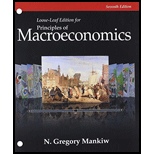
Bundle: Principles of Macroeconomics, Loose-Leaf Version, 7th + LMS Integrated Aplia, 1 term Printed Access Card
7th Edition
ISBN: 9781305242500
Author: N. Gregory Mankiw
Publisher: Cengage Learning
expand_more
expand_more
format_list_bulleted
Question
Chapter 22, Problem 4PA
Subpart (a):
To determine
Economy’s short-run and long-run Phillips curves.
Subpart (b):
To determine
Economy’s short-run and long-run Phillips curves.
Subpart (c):
To determine
Economy’s short-run and long-run Phillips curves.
Expert Solution & Answer
Trending nowThis is a popular solution!

Students have asked these similar questions
GDP
2017 Q3
2.8%
Equipment
9.8%
Nonresidential Structures
5.7%
2017 Q4
2.3
9.9
1.3%
2018 Q1
2.2
8.5
13.9
2018 Q2
4.2
4.6
14.5
2018 Q3
3.4
3.4
-3.4
2018 Q4
2.2
6.6
-3.9
(Note: all figures on an annual rate basis)
The quarterly growth rates of real GDP and investment spending on equipment and
structures for the six quarters prior to the pandemic are described above.
In his first term in office, Trump lowered both personal and corporate income tax rates,
expecting these moves to generate stronger growth. These took effect in January 2018
although the taxes withheld from paychecks did not drop immediately. Based on the data
above, did the tax cuts do what they were expected to do? Be specific.
Economists prefer to analyze the performance of the economy using “real” rather than nominal measures of economic activity. First, what does it mean to use real variables using consumption and wages as cases in point? Warning: before you throw at me the catch-all “adjusted for inflation” answer, know that I am looking for a thoughtful answer that explains in everyday English the difference between real and nominal and why it matters in the context of wages and interest rates.
Not use ai please
Chapter 22 Solutions
Bundle: Principles of Macroeconomics, Loose-Leaf Version, 7th + LMS Integrated Aplia, 1 term Printed Access Card
Knowledge Booster
Similar questions
- 3 Producer Surplus, PS $12 $11 S Book Print rences Legend ●Demand ● Supply Price $10 $9 $8 $7 $6 D $5 0 1 2 3 4 5 6 7 8 00 Tons of Wheat (in thousands) 9 10 a. Indicate the consumer surplus if the market is in equilibrium. Instructions: Use the tool provided "Consumer Surplus, CS" to shade in the consumer surplus area on the graph. b. Indicate the producer surplus if the market is in equilibrium. Instructions: Use the tool provided "Producer Surplus, PS" to shade in the producer surplus area on the graph.arrow_forwardFigure 4-4 PRICE a P B Q a QUANTITY Supply Refer to Figure 4-4. The movement from point A to point B on the graph is called a decrease in supply. an increase in supply. an increase in the quantity supplied. a decrease in the quantity supplied. tv all A 18arrow_forwardnot use ai pleasearrow_forward
- answer both question in the picture below swteo by step and give right answer please and explainarrow_forwardnot use ai pleasearrow_forwardA linear programming computer package is needed. As part of the settlement for a class action lawsuit, Hoxworth Corporation must provide sufficient cash to make the following annual payments (in thousands of dollars). 6 Year 1 23. 4 Payment 160 185 210 255 285 430 The annual payments must be made at the beginning of each year. The judge will approve an amount that, along with earnings on its investment, will cover the annual payments. Investment of the funds will be limited to savings (at 4% annually) and government securities, at prices and rates currently quoted in The Wall Street Journal. Hoxworth wants to develop a plan for making the annual payments by investing in the following securities (par value = $1,000). Funds not invested in these securities will be placed in savings. Security Current Price 1 $1,055 Rate (%) Years to Maturity 6.750 3 2 $1,000 5.125 Assume that interest is paid annually. The plan will be submitted to the judge and, if approved, Hoxworth will be required to…arrow_forward
- Put the sections of Cornell notes in the order of completion.arrow_forwardagree or disagree with the post Hi Class! Egyptian dates are much sweeter! Due largely to their climate and geography, Egypt, Saudi Arabia, Algeria, and Iran produce more dates than either the US or Canada. Dates grow best in hot dry climates with long dry growing seasons, which these nations naturally offer. They also produce a lot of dates because of their extensive agricultural, infrastructure, and centuries-old date-growing expertise. Conversely, the U.S., there aren't many places in Canada and California that are suitable for date farming, only a select few, like the Coachella Valley, in California can produce dates on a large scale. Although California produces some dates, it is not as much as countries like Saudi Arabia and Egypt. Depending only on U.S., because of increased labor and production costs, dates grown in this way may have a limited supply and raise prices. We can obtain a greater supply of dates at competitive prices while maintaining consistent quality by…arrow_forwardIn 1932 babe Ruth made $75,000. How much is that in todays dollars please give the right answer step by steparrow_forward
arrow_back_ios
SEE MORE QUESTIONS
arrow_forward_ios
Recommended textbooks for you
 Macroeconomics: Private and Public Choice (MindTa...EconomicsISBN:9781305506756Author:James D. Gwartney, Richard L. Stroup, Russell S. Sobel, David A. MacphersonPublisher:Cengage Learning
Macroeconomics: Private and Public Choice (MindTa...EconomicsISBN:9781305506756Author:James D. Gwartney, Richard L. Stroup, Russell S. Sobel, David A. MacphersonPublisher:Cengage Learning Economics: Private and Public Choice (MindTap Cou...EconomicsISBN:9781305506725Author:James D. Gwartney, Richard L. Stroup, Russell S. Sobel, David A. MacphersonPublisher:Cengage Learning
Economics: Private and Public Choice (MindTap Cou...EconomicsISBN:9781305506725Author:James D. Gwartney, Richard L. Stroup, Russell S. Sobel, David A. MacphersonPublisher:Cengage Learning Economics (MindTap Course List)EconomicsISBN:9781337617383Author:Roger A. ArnoldPublisher:Cengage Learning
Economics (MindTap Course List)EconomicsISBN:9781337617383Author:Roger A. ArnoldPublisher:Cengage Learning



Macroeconomics: Private and Public Choice (MindTa...
Economics
ISBN:9781305506756
Author:James D. Gwartney, Richard L. Stroup, Russell S. Sobel, David A. Macpherson
Publisher:Cengage Learning

Economics: Private and Public Choice (MindTap Cou...
Economics
ISBN:9781305506725
Author:James D. Gwartney, Richard L. Stroup, Russell S. Sobel, David A. Macpherson
Publisher:Cengage Learning

Economics (MindTap Course List)
Economics
ISBN:9781337617383
Author:Roger A. Arnold
Publisher:Cengage Learning


